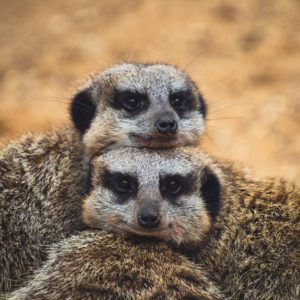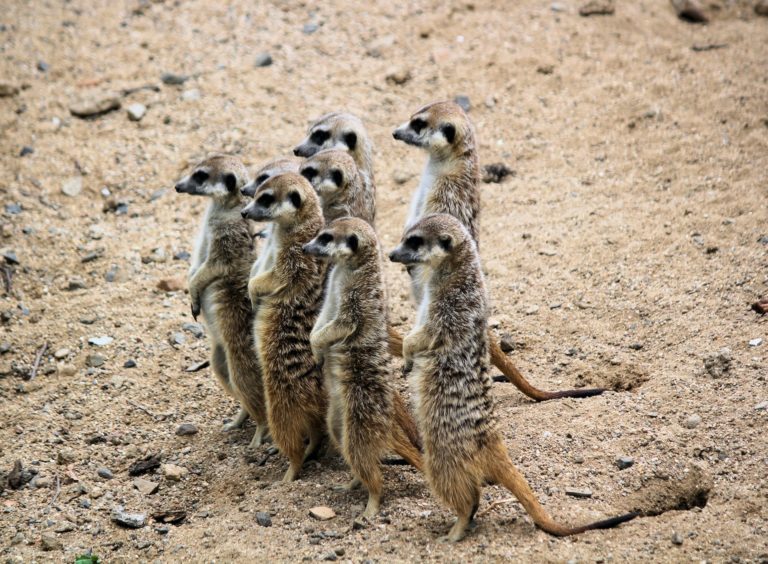Meerkat
Though they may be cute, turns out the meerkat is a murdering machine. It’s not just scorpions and mice either but each other. There’s a reason a group of meerkats is called a mob.
Main Notes and Takeaways
- Spend a lot of time underground in burrows that can be up to 15 feet wide.
- Have a very complicated language system which they can use to identify how strong a threat is (more below).
- Are extremely murderous. One study found them to have the highest rate of same species killing than any other mammal (more below).
- Meerkat groups are called mobs, and are led by a dominant female.



Our Favorite Notes from This Episode
Meerkat Language
Whether out foraging or relaxing at their burrow, meerkats always employ at least one lookout who looks for danger. When they see a threat like a predator they will call out to each other and their calls will change depending on how far away that predator is.
Meerkats constantly talk to each other while out foraging. By constantly talking they will create “vocal hotspots” which leads the group around the grassland by what is basically a voting system. The more meerkats that think they should be moving a certain way the more likely the group will follow. Even if the lead female “votes” to move on, they will wait until a majority agrees before moving on.
Meerkat Murder Mob
One 2016 study looked at 1000 different species of mammals and found that meerkats were the #1 most murderous species of their own kind. 19.4% of meerkat deaths were from other meerkats. Winning fights against other mobs means gaining territory which means more places to find food and water so there is a lot on the line. It has also been found that meerkat mobs with pups were more likely to stand their ground, and more likely to win fights. It seems having these extra mouths to feed motivated them.
But it’s not just strangers they will fight. In particular, pregnant dominant females will attack and kill the pups of non-dominant meerkats. In this way, she ensures that her pups get the most attention and have the highest chance of surviving.
If you’re curious, here’s the top ten most murderous animals of their own species:
- Meerkats
- Schmidt’s guenon
- Red-fronted lemur
- New Zealand sea lion
- Long-tailed marmot
- Lion
- Banded mongoose
- Grey wolf
- Chacma baboon
- Diademed sifaka and long-tailed chinchilla (tied)
Sources/Further Reading:
- Hill. T. Meerkat. Animal Diversity Web.
- Gómez, J., Verdú, M., González-Megías, A., Méndez, M. 2016. The phylogenetic roots of human lethal violence. Nature 538, 233-237.
- Dyble, M., Houslay, T., Manser, M., Clutton-Brock, T. 2019. Intergroup aggression in meerkats. Proc. R. Soc. B. 286: 20161993.
- Young, A., and Clutton-Brock, T. 2006. Infanticide by subordinates influences reproductive sharing in cooperatively breeding meerkats. Biol. Lett.2385–387.
- Rotics, S. and Clutton-Brock, T. 2021. Group size increases inequality in cooperative behaviour. Proc. R. Soc. B.2882020210420202104.
- Young, A., Spong G., and Clutton-Brock, T. 2007. Subordinate male meerkats prospect for extra-group paternity: alternative reproductive tactics in a cooperative mammal. Proc. R. Soc. B.2741603–1609
- Gall G., and Manser, M. 2017. Group cohesion in foraging meerkats: follow the moving ‘vocal hot spot’. R. Soc. open sci.4170004170004.
- Bousquet, C., Sumpter, D., and Manser, M. B. 2011. Moving calls: a vocal mechanism underlying quorum decisions in cohesive groups. Proc. R. Soc. B.2781482–1488
Did you spot an error or have questions about this post? Email Nicole Brown.
